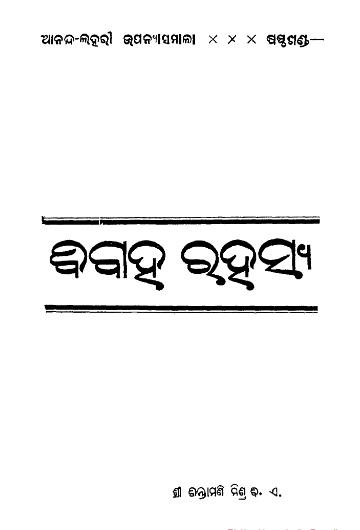In the vibrant tapestry of Odia literature, the novel Bibaha Rahasya, written by Chintamani Misra Senapati and published in 1931, stands out as a compelling tale that intertwines romance, societal norms, and the complexities of marriage. This work not only showcases Misra’s literary prowess but also reflects the cultural dynamics and societal expectations of early 20th-century Odisha, making it an important addition to the canon of Odia fiction.
At its core, Bibaha Rahasya, which translates to The Mystery of Marriage, delves into the intricacies of marital relationships and the often hidden truths that lie beneath the surface. The novel unfolds through a tapestry of characters, each representing various facets of society, from the traditional to the progressive. Misra Senapati masterfully navigates through these characters to explore the different dimensions of love, duty, and personal aspiration, thereby creating a rich narrative that resonates with readers on multiple levels.
One of the standout features of Bibaha Rahasya is its exploration of the institution of marriage as both a personal journey and a social contract. Misra Senapati presents marriage not merely as a culmination of romantic love but as a complex interplay of familial expectations, societal pressure, and individual desires. This multifaceted approach adds depth to the narrative, prompting readers to reflect on their own perceptions of marriage and relationships.
The protagonist’s journey in Bibaha Rahasya is emblematic of the struggles many faced during this transitional period in Indian society. As characters grapple with their roles and identities within the framework of marriage, the novel sheds light on the broader themes of gender equality and personal freedom. Misra Senapati’s portrayal of strong female characters who challenge traditional norms is particularly noteworthy, as it urges a reconsideration of women’s roles in society and the importance of agency in both love and marriage.
The language and style of the novel further enhance its appeal. Misra’s writing is characterized by its lyrical quality and emotional depth. His use of rich descriptions and metaphors paints vivid imagery, immersing readers in the cultural and social milieu of the time. This attention to detail not only brings the characters and settings to life but also underscores the significance of Odisha’s cultural heritage within the narrative.
Additionally, Bibaha Rahasya stands as a reflection of the changing societal values in the early 20th century. Misra Senapati’s insights into the evolving dynamics of marriage and love resonate strongly with contemporary audiences, as themes of self-discovery, societal pressure, and the quest for personal happiness continue to be relevant today. In this sense, the novel becomes more than a mere story; it acts as a lens through which readers can examine the persistent complexities of human relationships.
As a significant work of fiction, Bibaha Rahasya has also contributed to the evolution of the Odia novel as a literary form. It showcases the potential for storytelling to address and critique societal norms, paving the way for future writers to explore similar themes with nuance and sensitivity.
Books Info
| Books name | Bibaha Rahasya / ବିବାହ ରହସ୍ୟ |
| Author | Chintamani Misra |
| No Of pages | 113 |
| Publisher | Saraswata Bhandar |
| Publication | 1931 |
| Printed At | Saraswata Press |
| Distributor | NA |

